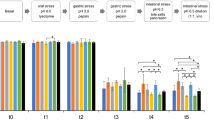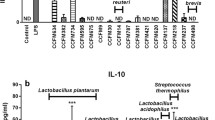Abstract
Some lactic acid bacteria (LAB), especially bacteria belonging to the genus Lactobacillus, are recognized as common inhabitants of the human gastrointestinal tract and have received considerable attention in the last decades due to their postulated health-promoting effects. LAB and probiotic bacteria can modulate the host immune response. However, much is unknown about the mediators and mechanisms responsible for their immunological effect. Here, we present a study using cytokine secretion from the monocytic cell line THP-1 and NF-κB activation in the monocytic cell line U937-3xkB-LUC to elucidate immune stimulating abilities of LAB in vitro. In this study, we investigate both commercially available and potential probiotic LAB strains, and the role of putative surface proteins of L. reuteri using mutants. L. reuteri strains induced the highest cytokine secretion and the highest NF-κB activation, whereas L. plantarum strains and L. rhamnosus GG were low inducers/activators. One of the putative L. reuteri surface proteins, Hmpref0536_10802, appeared to be of importance for the stimulation of THP-1 cells and the activation of NF-κB in U937-3xkB-LUC cells. Live and UV-inactivated preparations resulted in different responses for two of the strains investigated. Our results add to the complexity in the interaction between LAB and human cells and suggest the possible involvement of secreted pro- and anti-inflammatory mediators of LAB. It is likely that it is the sum of bacterial surface proteins and bacterial metabolites and/or secreted proteins that induce cytokine secretion in THP-1 cells and activate NF-κB in U937-3xkB-LUC cells in this study.



Similar content being viewed by others
References
Qin J, Li R, Raes J, Arumugam M, Burgdorf KS et al (2010) A human gut microbial gene catalogue established by metagenomic sequencing. Nature 464(7285):59–65. doi:10.1038/nature08821
Lebeer S, Vanderleyden J, De Keersmaecker SC (2008) Genes and molecules of lactobacilli supporting probiotic action. Microbiol Mol Biol Rev 72(4):728–764. doi:10.1128/MMBR.00017-08
Lebeer S, Vanderleyden J, De Keersmaecker SC (2010) Host interactions of probiotic bacterial surface molecules: comparison with commensals and pathogens. Nat Rev Microbiol 8(3):171–184. doi:10.1038/nrmicro2297
Ezendam J, Loveren H (2006) Probiotics: immunomodulation and evaluation of safety and efficacy. Nutr Rev 64(1):1–14
Marco ML, Pavan S, Kleerebezem M (2006) Towards understanding molecular modes of probiotic action. Curr Opin Biotechnol 17(2):204–210
Wells JM, Loonen LM, Karczewski JM (2010) The role of innate signaling in the homeostasis of tolerance and immunity in the intestine. Int J Med Microbiol 300(1):41–48. doi:10.1016/j.ijmm.2009.08.008
Bron PA, Tomita S, Mercenier A, Kleerebezem M (2013) Cell surface-associated compounds of probiotic lactobacilli sustain the strain-specificity dogma. Curr Opin Microbiol 16(3):262–269. doi:10.1016/j.mib.2013.06.001
Lee IC, Tomita S, Kleerebezem M, Bron PA (2013) The quest for probiotic effector molecules-unraveling strain specificity at the molecular level. Pharmacol Res 69(1):61–74. doi:10.1016/j.phrs.2012.09.010
van Baarlen P, Wells JM, Kleerebezem M (2013) Regulation of intestinal homeostasis and immunity with probiotic lactobacilli. Trends Immunol 34(5):208–215. doi:10.1016/j.it.2013.01.005
Adams CA (2010) The probiotic paradox: live and dead cells are biological response modifiers. Nutr Res Rev 23(1):37–46. doi:10.1017/S0954422410000090
Taverniti V, Guglielmetti S (2011) The immunomodulatory properties of probiotic microorganisms beyond their viability (ghost probiotics: proposal of paraprobiotic concept). Genes Nutr 6(3):261–274. doi:10.1007/s12263-011-0218-x
Hayden MS, Ghosh S (2008) Shared principles in NF-κB signaling. Cell 132(3):344–362. doi:10.1016/j.cell.2008.01.020
Vilček J (2003) The cytokines: an overview. In: Thomson AW, Lotze MT (eds) The cytokine handbook, 4th edn. Elsevier, London, pp 3–18
Mukaida N, Ketlinsky SA, Matsushima K (2003) Interleukin 8 and other CXC chemokines. In: Thomson AW, Lotze MT (eds) The cytokine handbook, 4th edn. Elsevier, London, pp 1049–1070
Wang H, Czura CJ, Tracey KJ (2003) Tumor necrosis factor. In: Thomson AW, Lotze MT (eds) The cytokine handbook, 4th edn. Elsevier, London, pp 837–853
Kataria J, Li N, Wynn JL, Neu J (2009) Probiotic microbes: do they need to be alive to be beneficial? Nutr Rev 67(9):546–550. doi:10.1111/j.1753-4887.2009.00226.x
Gobbetti M, Cagno RD, De Angelis M (2010) Functional microorganisms for functional food quality. Crit Rev Food Sci Nutr 50(8):716–727. doi:10.1080/10408398.2010.499770
Carlsen H, Moskaug JO, Fromm SH, Blomhoff R (2002) In vivo imaging of NF-κB activity. J Immunol 168(3):1441–1446
Rieder A, Grimmer S, Kolset SO, Michaelsen TE, Knutsen SH (2011) Cereal beta-glucan preparations of different weight average molecular weights induce variable cytokine secretion in human intestinal epithelial cell lines. Food Chem 128(4):1037–1043. doi:10.1016/j.foodchem.2011.04.010
Boyle RJ, Bath-Hextall FJ, Leonardi-Bee J, Murrell DF, Tang ML (2008) Probiotics for treating eczema. Cochrane Database Syst Rev (4):CD006135. doi:10.1002/14651858.CD006135.pub2
Osborn DA, Sinn JK (2007) Probiotics in infants for prevention of allergic disease and food hypersensitivity. Cochrane Database Syst Rev (4):CD006475. doi:10.1002/14651858.CD006475.pub2
Remus DM, Kleerebezem M, Bron PA (2011) An intimate tete-a-tete: how probiotic lactobacilli communicate with the host. Eur J Pharmacol 668(Suppl 1):S33–S42. doi:10.1016/j.ejphar.2011.07.012
Wells JM (2011) Immunomodulatory mechanisms of lactobacilli. Microb Cell Fact 10(Suppl 1):S17. doi:10.1186/1475-2859-10-S1-S17
Jensen H, Grimmer S, Naterstad K, Axelsson L (2012) In vitro testing of commercial and potential probiotic lactic acid bacteria. Int J Food Microbiol 153(1–2):216–222. doi:10.1016/j.ijfoodmicro.2011.11.020
Oh PL, Benson AK, Peterson DA, Patil PB, Moriyama EN et al (2009) Diversification of the gut symbiont Lactobacillus reuteri as a result of host-driven evolution. ISME J 4(3):377–387
Klingberg TD, Axelsson L, Naterstad K, Elsser D, Budde BB (2005) Identification of potential probiotic starter cultures for Scandinavian-type fermented sausages. Int J Food Microbiol 105(3):419–431. doi:10.1016/j.ijfoodmicro.2005.03.020
Ligaarden SC, Axelsson L, Naterstad K, Lydersen S, Farup PG (2010) A candidate probiotic with unfavourable effects in subjects with irritable bowel syndrome: a randomised controlled trial. BMC Gastroenterol 10:16. doi:10.1186/1471-230X-10-16
Thomas CM, Versalovic J (2010) Probiotics-host communication: modulation of signaling pathways in the intestine. Gut Microbes 1(3):148–163
Wullaert A (2010) Role of NF-κB activation in intestinal immune homeostasis. Int J Med Microbiol 300(1):49–56. doi:10.1016/j.ijmm.2009.08.007
Goto Y, Kiyono H (2012) Epithelial barrier: an interface for the cross-communication between gut flora and immune system. Immunol Rev 245(1):147–163. doi:10.1111/j.1600-065X.2011.01078.x
Jensen H, Roos S, Jonsson H, Rud I, Grimmer S et al (2014) Role of Lactobacillus reuteri cell and mucus-binding protein A (CmbA) in adhesion to intestinal epithelial cells and mucus in vitro. Microbiology 160(Pt 4):671–681. doi:10.1099/mic.0.073551-0
Pretzer G, Snel J, Molenaar D, Wiersma A, Bron PA et al (2005) Biodiversity-based identification and functional characterization of the mannose-specific adhesin of Lactobacillus plantarum. J Bacteriol 187(17):6128–6136. doi:10.1128/jb.187.17.6128-6136.2005
Roos S, Jonsson H (2002) A high-molecular-mass cell-surface protein from Lactobacillus reuteri 1063 adheres to mucus components. Microbiology 148(2):433–442
Edelman SM, Lehti TA, Kainulainen V, Antikainen J, Kylvaja R et al (2012) Identification of a high-molecular-mass Lactobacillus epithelium adhesin (LEA) of Lactobacillus crispatus ST1 that binds to stratified squamous epithelium. Microbiology 158(Pt 7):1713–1722. doi:10.1099/mic.0.057216-0
Bae T, Schneewind O (2003) The YSIRK-G/S motif of staphylococcal protein A and its role in efficiency of signal peptide processing. J Bacteriol 185(9):2910–2919
DeDent A, Bae T, Missiakas DM, Schneewind O (2008) Signal peptides direct surface proteins to two distinct envelope locations of Staphylococcus aureus. EMBO J 27(20):2656–2668. doi:10.1038/emboj.2008.185
Call EK, Klaenhammer TR (2013) Relevance and application of sortase and sortase-dependent proteins in lactic acid bacteria. Front Microbiol 4:73. doi:10.3389/fmicb.2013.00073
Marraffini LA, Dedent AC, Schneewind O (2006) Sortases and the art of anchoring proteins to the envelopes of gram-positive bacteria. Microbiol Mol Biol Rev 70(1):192–221. doi:10.1128/MMBR.70.1.192-221.2006
Spirig T, Weiner EM, Clubb RT (2011) Sortase enzymes in gram-positive bacteria. Mol Microbiol 82(5):1044–1059. doi:10.1111/j.1365-2958.2011.07887.x
Gross G, van der Meulen J, Snel J, van der Meer R, Kleerebezem M et al (2008) Mannose-specific interaction of Lactobacillus plantarum with porcine jejunal epithelium. FEMS Immunol Med Microbiol 54(2):215–223
Lin YP, Thibodeaux CH, Pena JA, Ferry GD, Versalovic J (2008) Probiotic Lactobacillus reuteri suppress proinflammatory cytokines via c-Jun. Inflamm Bowel Dis 14(8):1068–1083. doi:10.1002/ibd.20448
Thomas CM, Hong T, van Pijkeren JP, Hemarajata P, Trinh DV et al (2012) Histamine derived from probiotic Lactobacillus reuteri suppresses TNF via modulation of PKA and ERK signaling. PLoS One 7(2):e31951. doi:10.1371/journal.pone.0031951
Jones SE, Whitehead K, Saulnier D, Thomas CM, Versalovic J et al (2011) Cyclopropane fatty acid synthase mutants of probiotic human-derived Lactobacillus reuteri are defective in TNF inhibition. Gut Microbes 2(2):69–79
Hemarajata P, Gao C, Pflughoeft KJ, Thomas CM, Saulnier DM et al (2013) Lactobacillus reuteri-specific immunoregulatory gene rsiR modulates histamine production and immunomodulation by Lactobacillus reuteri. J Bacteriol 195(24):5567–5576. doi:10.1128/JB.00261-13
Eaton KA, Honkala A, Auchtung TA, Britton RA (2011) Probiotic Lactobacillus reuteri ameliorates disease due to enterohemorrhagic Escherichia coli in germfree mice. Infect Immun 79(1):185–191. doi:10.1128/IAI.00880-10
Preidis GA, Saulnier DM, Blutt SE, Mistretta TA, Riehle KP et al (2012) Host response to probiotics determined by nutritional status of rotavirus-infected neonatal mice. J Pediatr Gastroenterol Nutr 55(3):299–307. doi:10.1097/MPG.0b013e31824d2548
McCabe LR, Irwin R, Schaefer L, Britton RA (2013) Probiotic use decreases intestinal inflammation and increases bone density in healthy male but not female mice. J Cell Physiol. doi:10.1002/jcp.24340
Remus DM, Bongers RS, Meijerink M, Fusetti F, Poolman B et al (2012) The impact of Lactobacillus plantarum sortase on target-protein sorting, gastrointestinal persistence, and host immune response modulation. J Bacteriol. doi:10.1128/JB.01321-12
Nobbs AH, Vajna RM, Johnson JR, Zhang Y, Erlandsen SL et al (2007) Consequences of a sortase A mutation in Streptococcus gordonii. Microbiology 153(Pt 12):4088–4097. doi:10.1099/mic.0.2007/007252-0
Cross ML, Ganner A, Teilab D, Fray LM (2004) Patterns of cytokine induction by gram-positive and gram-negative probiotic bacteria. FEMS Immunol Med Microbiol 42(2):173–180
Wong C, Ustunol Z (2006) Mode of inactivation of probiotic bacteria affects interleukin 6 and interleukin 8 production in human intestinal epithelial-like Caco-2 cells. J Food Prot 69(9):2285–2288
Miettinen M, Vuopio-Varkila J, Varkila K (1996) Production of human tumor necrosis factor alpha, interleukin-6, and interleukin-10 is induced by lactic acid bacteria. Infect Immun 64(12):5403–5405
Kimoto-Nira H, Suzuki C, Kobayashi M, Mizumachi K (2008) Different growth media alter the induction of interleukin 12 by a Lactococcus lactis strain. J Food Prot 71(10):2124–2128
Cotter PD, Hill C (2003) Surviving the acid test: responses of gram-positive bacteria to low pH. Microbiol Mol Biol Rev 67(3):429–453. doi:10.1128/mmbr.67.3.429-453.2003
Begley M, Gahan CGM, Hill C (2005) The interaction between bacteria and bile. FEMS Microbiol Rev 29(4):625–651. doi:10.1016/j.femsre.2004.09.003
Kandler O, Stetter KO, Kohl R (1980) Lactobacillus reuteri sp. nov., a new species of heterofermentative lactobacilli. Zentralbl Bakterio. Mikrobiol Hyg I Abt Orig C 1(3):264–269
Rosander A, Connolly E, Roos S (2008) Removal of antibiotic resistance gene-carrying plasmids from Lactobacillus reuteri ATCC 55730 and characterization of the resulting daughter strain, L. reuteri DSM 17938. Appl Environ Microbiol 74(19):6032–6040. doi:10.1128/AEM.00991-08
Shrago AW, Chassy BM, Dobrogosz WJ (1986) Conjugal plasmid transfer (pAM beta 1) in Lactobacillus plantarum. Appl Environ Microbiol 52(3):574–576
Johansson ML, Molin G, Jeppsson B, Nobaek S, Ahrne S et al (1993) Administration of different Lactobacillus strains in fermented oatmeal soup: in vivo colonization of human intestinal mucosa and effect on the indigenous flora. Appl Environ Microbiol 59(1):15–20
Silva M, Jacobus NV, Deneke C, Gorbach SL (1987) Antimicrobial substance from a human Lactobacillus strain. Antimicrob Agents Chemother 31(8):1231–1233
Acknowledgments
This work was supported by the Fund for the Research Levy on Agricultural Products. The authors thank Marte Taraldrud for excellent technical assistance. The U937-3xkB-LUC cell line was a kind gift from Rune Blomhoff, University of Oslo.
Conflict of interest
The authors’ declares that they have no conflict of interest.
Author information
Authors and Affiliations
Corresponding author
Rights and permissions
About this article
Cite this article
Jensen, H., Drømtorp, S.M., Axelsson, L. et al. Immunomodulation of Monocytes by Probiotic and Selected Lactic Acid Bacteria. Probiotics & Antimicro. Prot. 7, 14–23 (2015). https://doi.org/10.1007/s12602-014-9174-2
Published:
Issue Date:
DOI: https://doi.org/10.1007/s12602-014-9174-2




